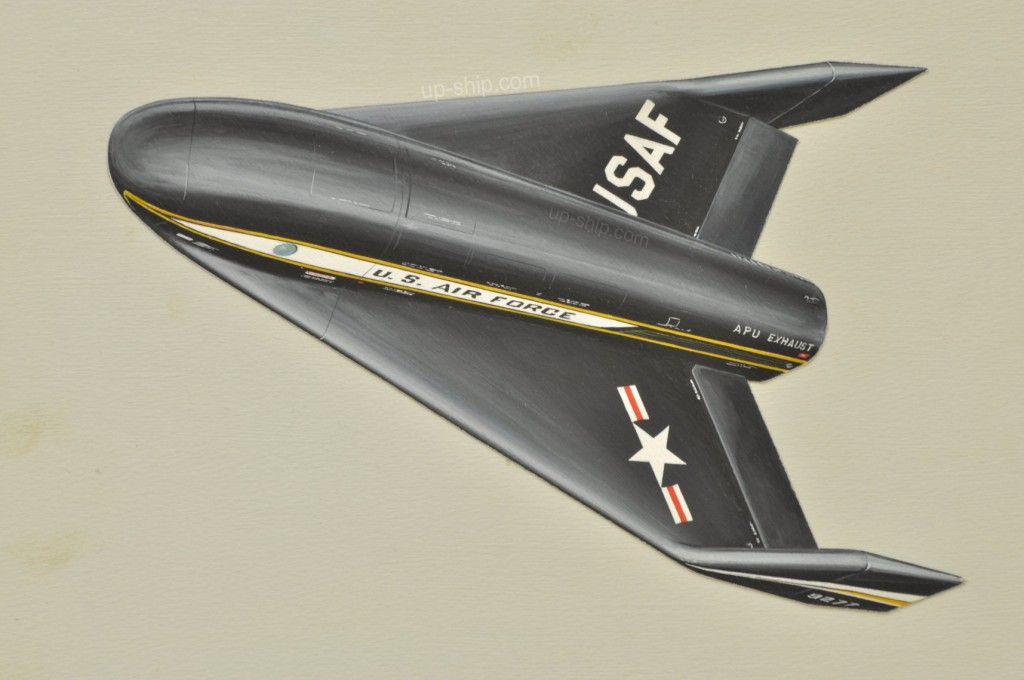The second of two pieces of full-color artwork photographed at the archive of the Ira G. Ross Aerospace Museum in Niagara Falls. Both of these were painted on thick matt board.
It was a rare joy to find (well, “be shown,” to be more precise) not only color artwork of an early Dyna Soar concept, but the *actual* artwork. There are a whole lot of crappily reproduced black and white artists concepts for the Dyna Soar and other programs… and for every one of these sad remnants, there was, and might still be, a full-color painting that some talented artist worked away at. Sadly, chances are that many if not most of these works of art have been destroyed. The art tends to remain the property of the company that paid to have it produced… and for the most part, companies don’t give a damn about preserving such things. Art takes up space.
5 Responses to “Bell-Martin Dyna Soar Artwork: 2”
Sorry, the comment form is closed at this time.

That actually looks like a more reasonable design than the final Boeing X-20 design with its pointy nose.
[…] drawings, history, projects, rockets, spacecraft Add comments May 132011 Same design as shown HERE and HERE. Note the inclusion of a turbojet engine for landing purposes, a common design element at […]
This is the final Bell designed Martin-Bell (Martin also tinkered with the config with its team of engineers, one being Hans Multhopp a brilliant and arrogant engineer who designed what he perceived to be a better mouse-trap (read flat-bottom boost-goider) that displayed blended splayed tip fins, a raised cockpit-it appeared to be one man with a fighter-like canopy, and the engine guts hanging out in the open and again, a too-pointed nose. Bell’s team was composed of Casey Forrest (X-16 super high altitude twin-engine-not one but two spyplane and several boost-glider projects, Bensen Hamlin, a senior engineer and flight test engineer, who was responsible for the preliminary design of the XS-1 and P-39, P-63, P-59 and Shrike/Rascal projects and Project manager for what is believed to be either Hi-Fi Recce and/or Brass-Bell and RoBo with guidance from Dr. Dornberger as consultant. The Bell design was such that those “si-fi” side portholes did offer forward visibility, while a retractable periscope system as proposed for X-16 would allow forward vision for landings. It saved much monies from special reaised cockpits and the framework-special glass and such and was considered a viable method having been tested on an F-86 and another aircraft to prove the point. It was lightweight overall, possessed a forward capsule, not the feeble ejection seat, demanded by USAF for Boeing’s DS, and utilized Bell’s patented cooling-insulation system wrapped around what Bell claimed could be a simply aluminum aircraft structure! USAF believed them although it needed much tuning and tweaking that this system was tested well into 1967, long after DS was supposedly cancelled over at Boeing. Niagara Aerospace possesses a model of this final version, but seem unwilling to believe that my Identification of it is correct…of course they do not possess all the documentation, and I have not shared it with them. Their Bell Dyna Soar always remains a drawing of the Boeing M844-2050E version, not the Bell version, despite repeated attempts to convince them. Not being an ex-Bell employee, or an East Coaster…go figure!
I retract the F-86 periscope test…that was done with Boeing’s Model 814-1047 & 1050-1’s tiny front window instead. I sent the drawing to Niagara Aerospace to convince them of what the Bell final design looked like (April 1959 final config), although it started out in early 1958 as the late model BoMi standing in for Bell’s March, 1958 submission to the USAF DSSPO (Dyna Soar Systems Project Office). USAF continued from the mid-1950s to fund Bell’s cooling-insulation system and it was actually tested numerous times; a complete and actual center section of a boost-glider probably from one of their designs (the Bell Phase 1 Alpha study yielded a very handsome advanced boost-glider still without the raised cockpit and expensive frame-glass ala Boeing’s 1050-1 and 8050E models) was actually built and subjected to many tests of the liquid cooling system as well as the insulation package around it. Tis a shame that LeMay promised Boeing’s B Allen the DS contract since they lost the WS-110 competition…B-70 that is, but USAF, early on, shared Bell wind tunnel data from various tunnel tests, with Boeing, that they quicklyh got rid of that whacky pilot-killer 814-1010 configuration! The data sharing comes from a surviving Boeing wind tunnel man, who stated that information was shared with Boeing engineers that they engaged in a rapid geneological series of models culminating in the 1047-1 sporting black-white-red paint to look spiffy on display, and the sinister-looking all business dark 1050-1. Nuff said.
D
[…] reduced rez of this was posted before, but now you can get the full-rez […]